The Richard Alston Dance Company at Montclair State University’s Peak Performances, February 2 through 5.
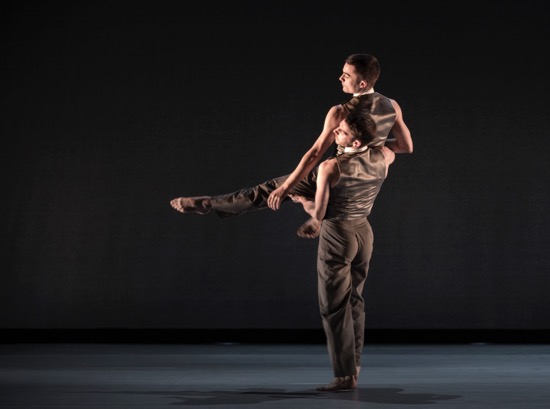
Nicholas Bodych lifts Liam Riddick in Richard Alston’s Mazur. Photo: Marina Nevitskaya
What seems different? I’m sitting in the Alexander Kasser Theater at Montclair State University, waiting for the Richard Alston Dance Company to begin dancing. Having for some years attended events presented at Montclair State’s Peak Performances series, I’m now part of a full house of excited people, many of whom seem to know one another (for weekend performances, a charter bus runs from Manhattan, but this is Thursday). An audience in this theater has not always, in my experience, filled it, and I could never quite understand why the modest price of a ticket ($20) and the free pass to undergraduates at the university weren’t luring more people to see the high-quality, often cutting edge theater, music, and dance performances engineered by Peak Performance’s executive director, Jedediah Wheeler.
What else is new? A handsome brochure—a magazine really—with articles about the 2016-2017 season. The London-based Richard Alston Dance Company, however, is not new to Montclair audiences, having appeared there in 2012 and 2014. This year it offers a world premiere, Part II of Alston’s Chacony, which was commissioned by Peak Performances, and Chacony as a whole boasts two musical groups—surely a first. For Part I, the Repast Baroque Ensemble plays Henry Purcell’s Chacony in G Minor (ca. 1680) from the pit, and when Part II begins, members of the Shanghai Quartet, who have been sitting in semi-darkness at the back of the stage, are suddenly illuminated and begin to play the Chacony from Benjamin Britten’s 1945 String Quartet no. 2 in C Major, an homage to Purcell, whose Chacony (another way of referring to the musical form “chaconne”) Britten arranged centuries later.
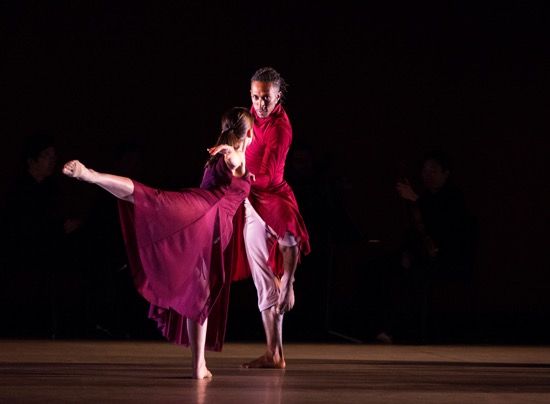
Jennifer Hayes and Ihsaan de Banya in Part I of Richard Alston’s Chacony. Photo: Marina Levitskaya
All ten members of the company are onstage when the curtain goes up, clustered by gender. They’re all wearing long, handsome, open-at-the-bottom red coats (by Peter Todd) over white garments, but will return for Part II minus the coats, in easy-going contemporary grays, beiges, and whites. Since this work is the last of four on the program, the audience has become acclimated to Alston’s musicality and to his preference for big, fluid, spacious movements that involve a dancer’s entire body at once. His style is also essentially peaceful; no hurricanes or inner tempests take these people over. During Part I, they may leave the stage and return, but when all five couples are assembled, their dancing skeins harmonious cats-cradles over the stage.
Part II brings out their diversity, and Britten’s music, unlike Purcell’s is dark and calculatedly unruly, its texture sliding between stormy and frail. Britten played music with Yehudi Menuhin in the German camps of World War II, just after these were liberated, and his composition reflects some of his horror. Alston has chosen to bring out the individuality of his dancers in this section, as if they, too, were on a voyage of discovery.
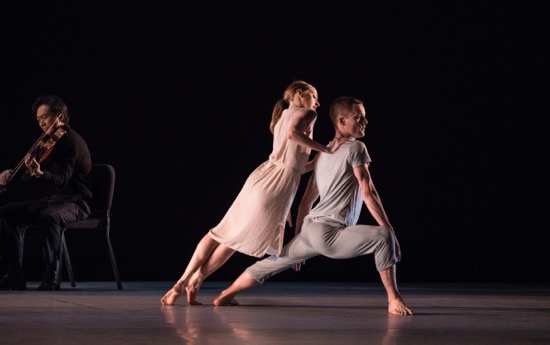
Elly Braund and Liam Riddick in Part II of Chacony. Visible at back: Honggang Li, violist for the Shanghai Quartet. Photo: Marina Levitskaya
James Muller enters alone and dances quietly to Britten’s legato opening passage; suddenly he falls. Others return: Ihsaan de Banya with Oihana Vesga Bujan, Liam Riddick carrying Elly Braund. Riddick is alone when the cello urges him into more assertive dancing, but for while, he and Braund seem, subtly, to be leaders. They’re in the foreground, moving differently from the four other couples dancing in unison behind them and not noticing when their companions leave. A duet between Monique Jonas and Muller is tender, dreamy. In this quietly changeable atmosphere, these last two look at de Banya before leaving him alone onstage; Bujan enters and goes to him. Near the end, Britten’s music becomes stronger, more confident, and the dancing of the remaining cast members (Nicholas Bodych, Jennifer Hayes, Nancy Nerantzi, and Nicholas Shikkis) presages that. The last image, after these two pairs have embraced and separated, is of all ten dancers holding hands and advancing slowly toward us.
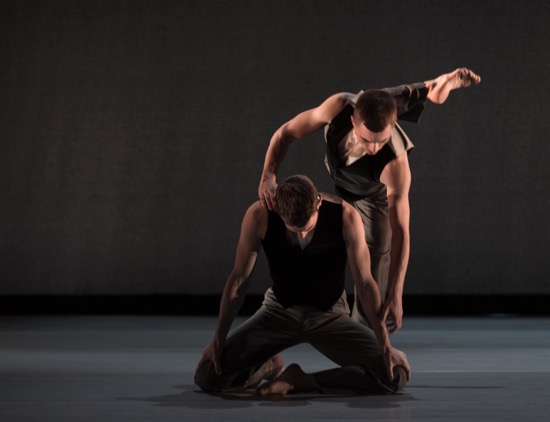
Nicholas Bodych (kneeling) and Liam Riddick in Richard Alston’s Mazur. Photo by Marina Levitskaya
One of the finest works of the evening is Alston’s duet for Riddick and Bodych entitled Mazur after the seven Chopin mazurkas that accompany it. Jason Ridgway plays these marvelously on a piano set in a far corner of the stage. The choreography makes few obvious references to Chopin’s Poland and the mazurka as a dance form beyond the occasionally flexed foot or rhythmic stamps. In part because of the accompaniment’s suite form, there are breathing pauses amid the dancing. This comradeship goes beyond the handshake that we see. The two men are intensely aware of each other; dancing in unison seems to involve scrutiny and permission. In the solos that both perform, each seems to be telling the other a story. And when they dance as partners, the ways in which one leans on or lifts his friend suggest that they cherish these moments together, as if the music were a stream along which they travel.
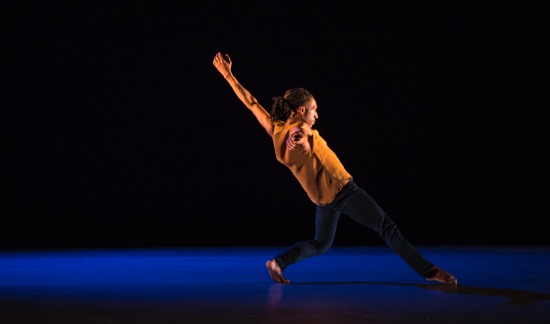
Ihsaan de Banya in Stronghold by Martin Lawrance. Photo by Marina Levitskaya
The music for Stronghold is nowhere near as nostalgic. This piece by RADC’s associate choreographer and rehearsal director, Martin Lawrance, is set to a composition of the same name by Julia Wolfe. The sometimes repetitive wrangling and whining and calming down and singing together of eight double basses (not played live!) have inspired a more contemporary vision of society—one in which people may wrench themselves and others around. In Part I of two, they often come from, or return to a line, across the back of the stage, making occasional contacts. The company’s souvenir program offers possible definitions of the title: “a fortress, a protected place, an area dominated by a particular group, a place of survival or refuge.” There seems to be little contention among these people. In Part II, de Banya is listed in the program as being the (or “a”) Watchman. No literal drama involving warning of potential danger emerges—at least not that I could discern—but de Banya dances marvelously in Stronghold, his slender, leggy body an undulating whirlwind of motion and of resistance. And when the performers leap, bent aggressively forward, it’s the air that they’re attacking.
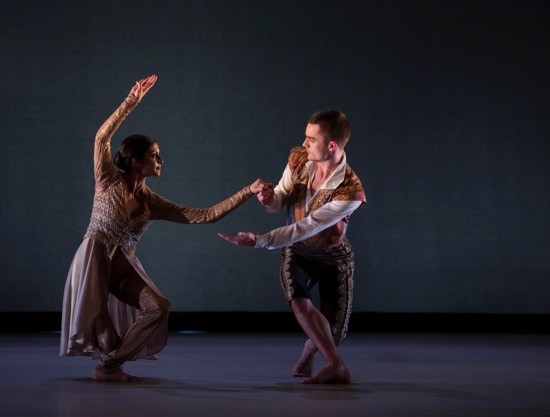
Vidya Patel and Liam Riddick in An Italian in Madrid, choreographed by Richard Alston. Photo by Marina Levitskaya
The program in the Alexander Kasser Theater opened with Alston’s An Italian in Madrid—like Stronghold and Mazur, making its first appearance in America. This time, the music is by Domenico Scarlatti, and although all ten of the pieces are sonatas for keyboard, the first three (K.146, K. 284, and K. 39) are played on an accordion, as recorded by Teodor Anzellati; Ridgway plays the remaining seven on the onstage piano. It’s very odd to listen to music that I first heard on a harpsichord squeezed out (with virtuosity) on an instrument that can make even a clipped note sound like a sigh. Alston’s musical choices are made clear by his semi-scenario. Part I of An Italian in Madrid is laid in Naples, the composer’s birthplace, where de Banya as Scarlatti plays around with RADC’s five women dancers, clad in pretty, wind-blown dresses by Fotini Dimou and lit by Karl Oskar Sørdal. Stealing a kiss is a possibility.
Part II is set in Lisbon, where Scarlatti travelled to instruct the young Princess Maria Barbara in music and attend her betrothal to the Spanish Prince Fernando (later accompanying her to Madrid, because she couldn’t bear to be without him). Now Ridgway tackles the piano, with lustrous results. The excellent Riddick, identified by his commanding manner and his vest, plays the suitor and guest dancer Vidya Patel is his bride-to-be; the remaining dancers (all barefoot) play their courtiers. What’s interesting (and a bit puzzling) about the casting is that the charming Patel is primarily a dancer in the North Indian Kathak style, and she is costumed in an outfit that might pass muster in a Mughal court. You see hints of Kathak, too, in her dancing (certain cat-like jumps for instance). But the premise is that these young people from different kingdoms, not from different cultures, are getting acquainted. Patel dances for Hiddick; then a chair is brought in for her, and she watches him dance. Sweetly and slowly, they move together.
I admit to being confused too by Alston’s characterization of Scarlatti in Part II. Perhaps he wanted to point him up as an outsider in Lisbon, but his position as the princess’s teacher, a 34-year-old with quite a reputation as a composer, is not entirely clear.
There’s a lot of coming and going and juicy dancing in Part II of An Italian in Madrid (even though he’s in Lisbon). Alston, as usual, gets under the skin of the gorgeous music that he uses and creates movement that refreshes one’s spirit. If there’s a flaw in this piece, it’s that Scarlatti carries him forcefully along. Especially in Part I, I may see a luscious passage and think, “stay there a few more seconds,” but the choreography has moved on and daren’t dally. My ears tolerate that in the music—delight in it—but my eyes crave an occasional rest in which to consolidate the beauty I’ve just seen.
When Chacony, the last piece of the evening, ended on opening night, the audience gave the company and the dances a very well-deserved standing ovation. Their way of saying, “Welcome back to Montclair.” Indeed!

Thanks for this thoughtful review Deborah. I think Alston is one of most under appreciated of contemporary choreographers. Maybe it has something to do with his, as you so astutely point out, “essential peacefulness”. I love his choice of music as well and his loving choreographic response to it and to human relationships. Wish I could have seen Masur
A fulsome and glowing review Deborah, thank you. I’m glad you and the audience enjoyed it. As former CEO of The Place in London, where Richard and his company are resident, may I, at the risk of being picky, point out one small error in one of the dancer’s names: Liam Riddick appears erroneously as ‘Hiddick’.
I am grateful to Kenneth Tharp for pointing out my typo. As my only editor, I sometimes fail myself-the-writer. Needless to say, the correction has been made. My apologies to Liam Riddick.